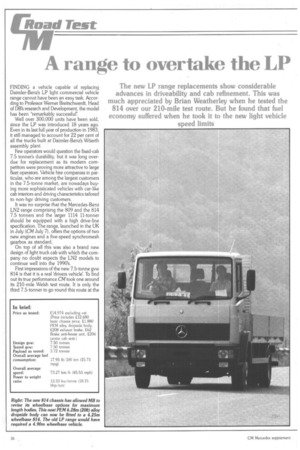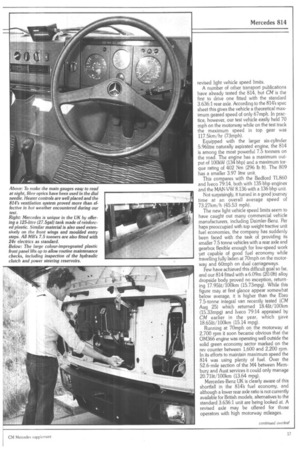A range to overtake the LP
Page 142

Page 143

If you've noticed an error in this article please click here to report it so we can fix it.
FINDING a vehicle capable of replacing Daimler-Benz's LP light commercial vehicle range cannot have been an easy task. According to Professor Werner Breitschwerdt, Head of DB's research and Development, the model has been "remarkably successful".
Well over 300,000 units have been sold, since the LP was introduced 18 years ago. Even in its last full year of production in 1983, it still managed to account for 22 per cent of all the trucks built at Daimler-Benz's Woerth assembly plant.
Few operators would question the fixed-cab 7.5 tonner's durability, but it was long overdue for replacement as its modern competitors were proving more attractive to large fleet operators. Vehicle hire companies in particular, who are among the largest customers in the 7.5-tonne market, are nowadays buying more sophisticated vehicles with car-like cab interiors and driving characteristics tailored to non-hgv driving customers.
It was no surprise that the Mercedes-Benz LN2 range comprising the 809 and the 814 7.5 tonners and the larger 1114 11-tonner should be equipped with a high drive-line specification. The range, launched in the UK in July (CM July 7), offers the options of two new engines and a five-speed synchromesh gearbox as standard..
On top of all this was also a brand new design of light truck cab with which the company no doubt expects the LN2 models to continue well into the 1990's.
First impressions.of the new 7.5-tonne gvw 814 is that it is a real 'drivers vehicle'. To find out its true performance CM took one around its 210-mile Welsh test route. It is only the third 7.5-tonner to go round this route at the revised light vehicle speed limits.
A number of other transport publications have already tested the 814, but CM is the first to drive one fitted with the standard 3.636:1 rear axle. According to the 814's spec sheet this gives the vehicle a theoretical maximum geared speed of only 67mph. In practice, however, our test vehicle easily held 70 mph on the motorway while on the test track the maximum speed in top gear was 117.5km/hr (73mph).
Equipped with the larger six-cylinder 5.96litre naturally aspirated engine, the 814 is among the most powerful 7.5 tonners on the road. The engine has a maximum output of 100kW (134 bhp) and a maximum torque rating of 402 Nm (296 lb ft). The 809 has a smaller 3.97 litre unit.
This compares with the Bedford TL860 and lveco 79:14, both with 135 bhp engines and the MAN-VW 8.136 with a 136 bhp unit.
Not surprisingly, it turned in a good journey time at an overall average speed of 73.27km /h (45.53 mph).
The new light vehicle speed limits seem to have caught out many commercial vehicle manufacturers, including Daimler-Benz. Per haps preoccupied with top weight tractive unit fuel economies, the company has suddenly been faced with the task of providing its smaller 7.5 tonne vehicles with a rear axle and gearbox flexible enough for low-speed work yet capable of good fuel economy while travelling fully laden at 70mph on the motorway and 60mph on dual carriageways.
Few have achieved this difficult goal so far, and our 814 fitted with a 6.09m (20.0ft) alloy dropside body proved no exception, returning 17.951it/100km (15.73mpg). While this figure may at first glance appear somewhat below average, it is higher than the Ebro 7.5-tonne integral van recently tested (CM Aug 25) which returned 18.41it/100km (15.33mpg) and Iveco 79:14 appraised by CM earlier in the year, which gave 18.651it/100km (15.14 mpg).
Running at 70mph on the motorway at 2,700 rpm it soon became obvious that the 0M366 engine was operating well outside the solid green economy sector marked on the rev counter between 1,600 and 2,200 rpm, In its efforts to maintain maximum speed the 814 was using plenty of fuel. Over the 52.6-mile section of the M4 between Membury and Aust services it could only manage 20.711ft/100km (13.64 mpg).
Mercedes-Benz UK is clearly aware of this shortfall in the 8I4's fuel economy, and although a lower rear axle ratio is not currently available for British models, alternatives to the standard 3,636:1 unit are being looked at. A revised axle may be offered for those operators with high motorway mileages.




























































































































































